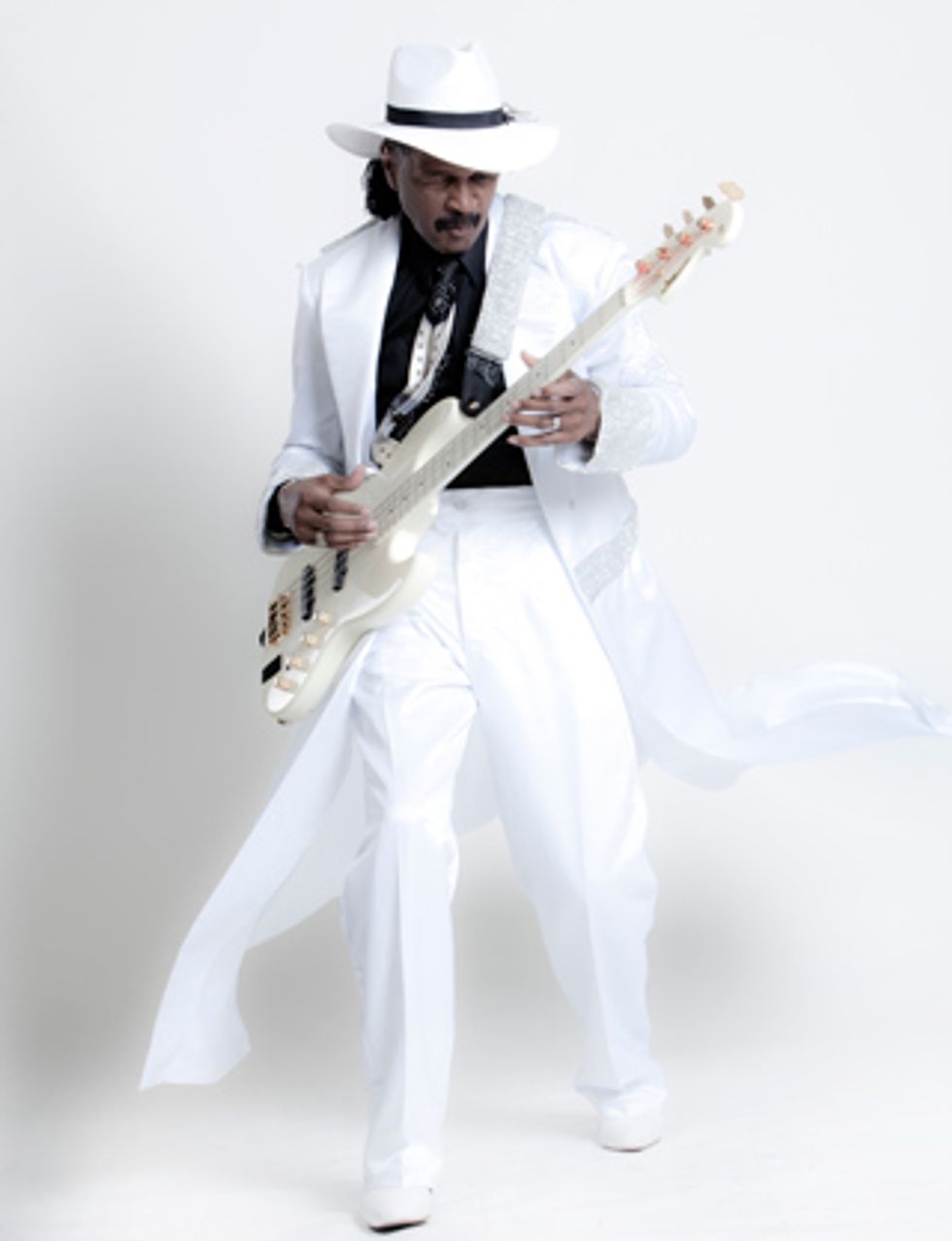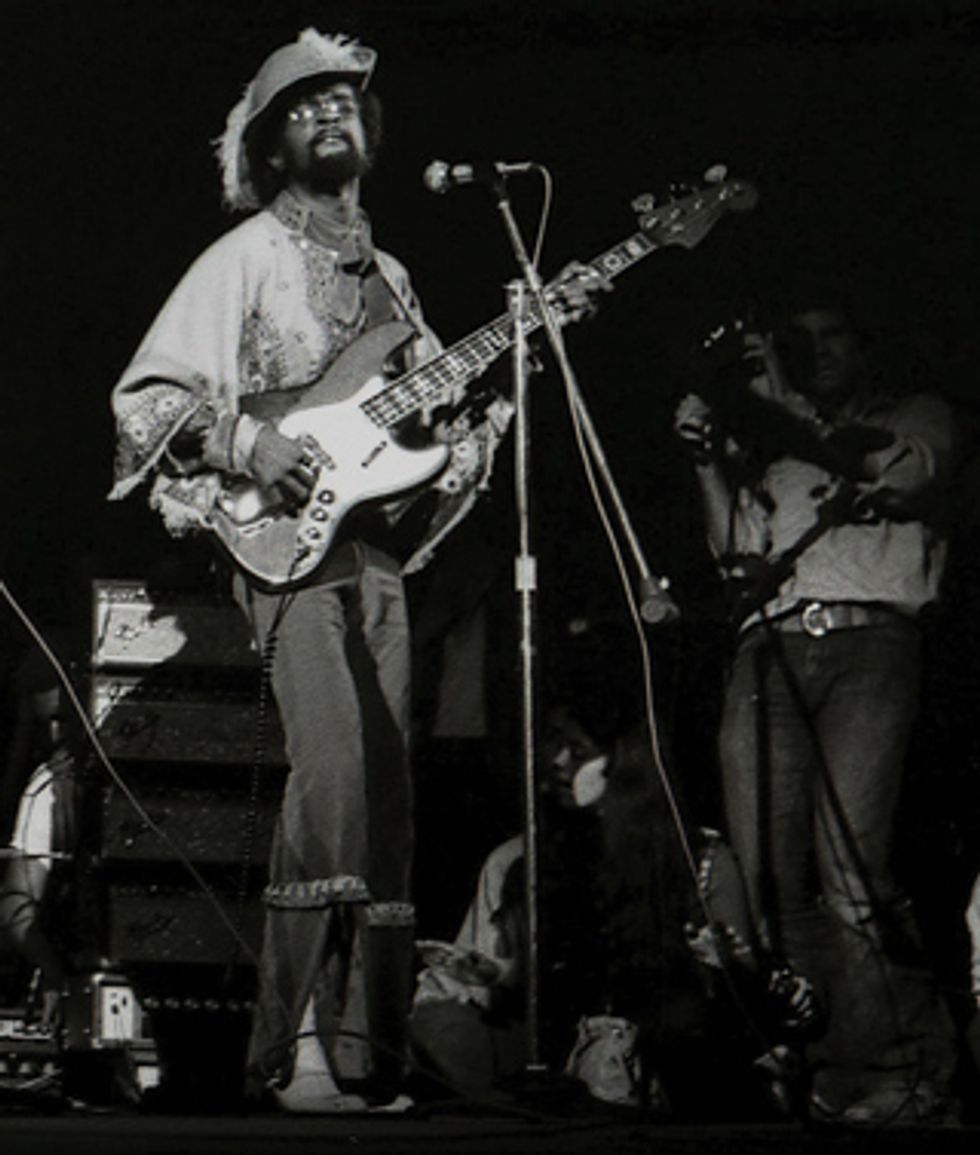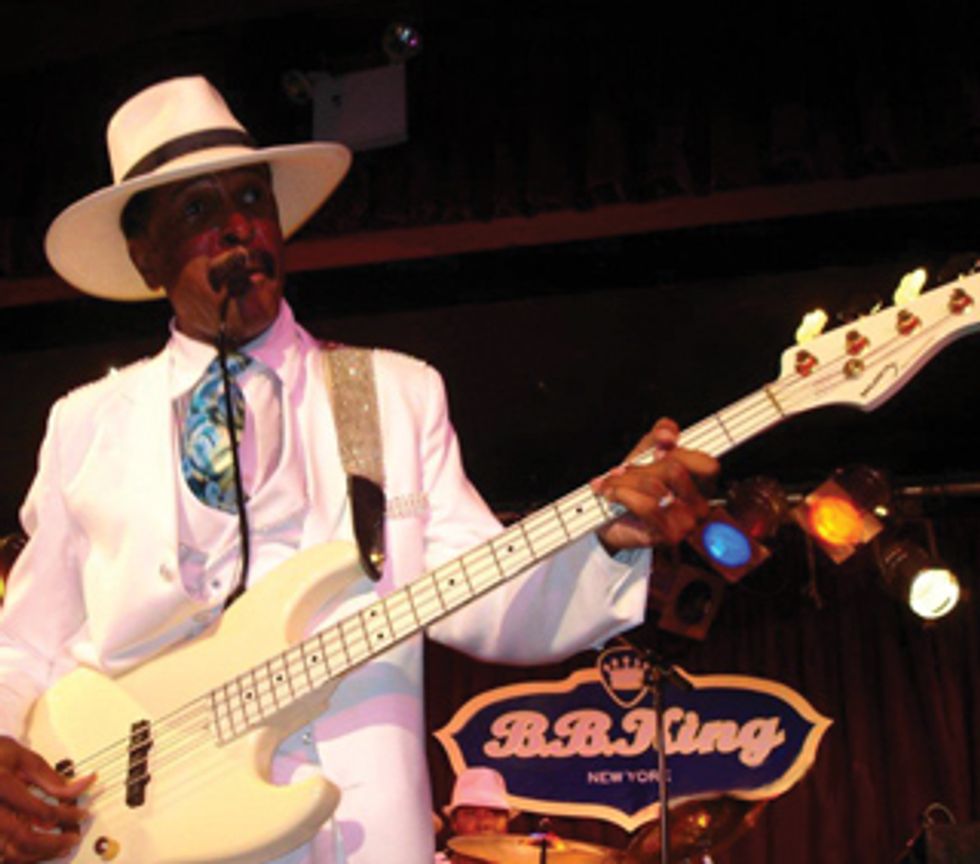
Photo by Erich Francois
“When I hear other bass players playing like me,” says Larry Graham—the funk god who invented and popularized the electric-bass slapping-and-popping technique with Sly and the Family Stone in the late 1960s—“I just think, ‘There’s another one of my children!’”
That’s a lot of kids. The technique— heard in megahits such as “I Want to Take You Higher” and “Thank You (Falettinme Be Mice Elf Agin)”—won Graham a page in music history and went on to become a cornerstone technique for players from Stanley Clarke to Bootsy Collins, Marcus Miller, Les Claypool, Flea, Doug Wimbish, and Victor Wooten, each of whom has spawned his own fanatical following, thus exponentially increasing Graham’s influence. Indeed, although Graham prefers to call the technique “thumpin’ and pluckin’,” it’s no overstatement to say that his playing has impacted the world of electric bass with the same force and universality that Jimi Hendrix’s did for the electric guitar.
Graham has been leading his own Graham Central Station band for nearly four decades now, and his first album in more than a decade, Raise Up, proves the legend hasn’t slowed down a bit. With newly recorded versions of GCS classics like “It’s Alright” and “Now Do U Wanta Dance,” as well as fresh new tracks like “Throw-N-Down the Funk,” Raise Up both frames the breadth of Graham’s legacy and demonstrates his band’s potent live sound. In addition, the album features cool cameos by players such as Raphael Saadiq and Prince—who plays drums, keyboards and backing vocals on the title track, and lays down liquid lead-guitar tracks on “Shoulda Coulda Woulda.” Throughout, GCS churns out funk fire and finesse, with Graham dialing up fuzzy, phased tones in spots, and longtime guitarist William Rabb and blazing new drummer Brian Braziel turning in dazzling performances on a furiously funky cover of the Stevie Wonder classic “Higher Ground.”
“I’m very fortunate,” says Graham. “All of our players were raised on my music, and at the same time they’re very open to progression. So they can play the old stuff as close to the originals as possible, but when it’s time for where we’re going next, they’re all right there.”
We recently spoke to Graham, 66, about his pioneering playing and the influence he’s had on the world of bass guitar. Like many veterans who’ve been at it their whole lives, he’s at the point where gear and tone settings are secondary or even tertiary to feel and vibe. He prefers to let his recent music speak for itself, but he was more than happy to talk about the cataclysmic funk that one inspired player with fantastically attuned hands and ears can deliver.
You get a really full-throated
tone on the new album. How
do you capture your sound in
the studio?
I close-mic the amps in the
studio—because I want that
amp sound—but I still record
direct, as well, because I want
the cleanness and the power
and the punch from the direct
sound. Once I record them, I
blend the two by ear to make
it sound the way I want it. It’s
different, live: I don’t mic the
amps onstage, although I do
send a direct signal out of the
back of two of the amps to the
mixing board.
What were you trying to
accomplish with Raise Up?
I intended it to be a complete
piece, like a book, with a great
beginning, a body of content in
the middle, and a great conclusion.
The idea was to create a
complete journey. That’s why
I wanted to include some of
the early GCS stuff, as well as
the current stuff. It’s also why
I wanted to include Prince—because of this close connection
between him and me—and also
Raphael Saadiq, being out of
Oakland, and Stevie Wonder,
being such a close friend and
having done so many things
together. I think it really says
what I’m all about. If you were
to pick up a book and read
about me, that’s what it would
sound like!
Can you tell us a bit about
your songwriting process?
A lot of it’s just singing the
parts into a tape recorder before
I even get a chance to sit down
with the instrument. Sure, if
I’m at an instrument—say, a
guitar—I’ll play the chords,
like I did when I wrote “Ole
Smokey,” which is a guitar-type
tune. Songs like “Today” or
“Just Be My Lady” or “Hold
You Close” are things I wrote
on the piano. A song like
“Hair” is obviously built around
the bass, so it was written on
the bass. “Got to Go Through
It to Get to It” is built around
a pretty intricate drum beat,
so in that case the beat came
first. I’ve been blessed to have
learned quite a few instruments,
and though I’m not a master
of those instruments—no
one’s going to ask me to be the
drummer in their band—I can
lay down the parts I hear in my
head, and many times I’ll even
keep those parts in the final
recordings. If I record something
at home that works great
and I can’t seem to duplicate it,
I’ll keep that, too. I played guitar
before the bass, and I played
the drums before that—so, I’m
not locked into any one method
of songwriting. However [the
song] comes, I’m going to move
forward from that.
Over all these years, you’ve
steadfastly stuck to calling
your revolutionary technique
“thumpin’ and pluckin’.” Let’s
talk about why you like to
make that distinction.
Well, it really is thumpin’ and
pluckin’! You can give it another
name, but it’s still thumpin’
and pluckin.’ When you hit
the string with the side of
your thumb, you’re thumpin’
it more than slapping it, and
when you’re poppin’ that G
string, like I do on “Thank You
(Falettinme Be Mice Elf Agin),”
you’re really pluckin’ it. Y’know,
for people who aren’t musicians,
I can understand why they don’t
understand that—and they can
call it anything they want, as
long as they’re referring to the
same technique. I’m sure that
in the future, some new names
will get added—I’ve heard
“pop bass,” and “chopper bass,”
which is what some people call
it in Japan. There’s a whole list
of names, depending on where
you live, but when you see and
hear it, it’s all the same thing.

Larry Graham lays down the funk with Sly and the Family Stone at the Woodstock Festival in 1969. Photo by Jason Laure (Frank White Photo Agency)
Has the style you developed
way back in the ’60s changed
much over the years?
My technique is fundamentally
the same as it was back in the
late ’60s, because my heart
hasn’t changed—and when I
play, I play from the heart. Of
course, you grow in your understanding
of harmony, your
grasp of different feels, and you
benefit from exposure to other
people’s music. I mean, since I
came up with this style, we’ve
all lived through so many different
genres and styles, and the
way that I play the bass has now
spread throughout all genres of
music. So, my style is basically
the same, but everything I’ve
experienced as a person, as a listener,
and as a player all comes
out in my playing now.
Do you remember the first time
you thumped and plucked?
Y’know, the first time I played
bass I didn’t immediately start
thumpin’ and pluckin.’ Before
then, in my mother’s group
[the Dell Graham Trio, which
Graham joined at age 15], I was
on guitar and my mother was
on piano and we had a drummer.
So when I would take a
solo, she would be playing the
bass lines with her left hand on
the piano, and when she would
solo, then I would play bass
lines on the guitar. So the biggest
influence for me, in terms
of bass patterns, at that time,
would be her left hand. Later,
when my mother decided to no
longer use drums—and I still
don’t know if that was mostly
for economic reasons—that’s
when I started to thump the
strings to get that groove going.
But the way I started playing bass in the first place was that I had been playing the bass pedals of an organ with my feet at the same time as I was playing the guitar. We were getting used to having that extra bottom there, but at some point the organ broke down, so we missed the bottom. That’s why I went out and rented this St. George electric bass, and I rented it because I was going to take it back as soon as the organ was repaired! My first love was still the guitar! But it turned out that the organ couldn’t be repaired, and that’s how I got stuck on the bass. When my mom decided she was no longer going to have a drummer, that’s when I started thumping the strings—to make up for not having that bass drum—and plucking the strings to make up for not having the backbeat on the snare drum. I was basically trying to play drums on the bass to compensate for not having a drummer.

Larry Graham plays his signature Moon J-style bass with Graham Central Station at the B.B. King Blues Club & Grill in New York City on June 16, 2010. Photo by Adam Sands (Frank White Photo Agency)
Do you recall getting a strong
reaction from people when
you started playing that way?
I don’t remember any strong
reaction to it at the time,
though I remembering thinking
that if any professional
musicians heard me, they’d
think, “What is he doing? He’s
not playing the correct way.”
Meaning, y’know, the correct
overhand style of bass playing.
But the people at the club were
just enjoying what they were
hearing. When I look back, I
wonder if my style would have
ever meant anything to anybody
if Sly [Stone] hadn’t come down
and heard me at the club, loved
what he heard, and asked me to
join this new band that didn’t
even have a name yet.
But because of all those hit records we had, and because of other bass players seeing me on TV and wondering, “What is that guy doing?” it really caught on. Even in the ’70s, if you were in a cover band playing those Sly songs, you really had to play them the way I was playing them. So as a result of our success, other original bands started writing stuff that required their bass players to start thumpin’ and pluckin’ on their original songs. Of course, from there it spread even further. But until it became something famous, I really didn’t see anybody trippin’ on it. I never got that sort of “Wow, look what he’s doing!” People just seemed to enjoy my mother and I as a duo, with both of us singing and playing.
So where exactly does your right
hand thumb contact the string?
Most of the time, it hits the
string just ahead of the back
[J-style] pickup—between the
two pickups, but much closer
to the bridge pickup. You get
a slightly different tone back
there than you do if you thump
the string closer to the edge
of the fretboard—which I also
do, depending on the sound
I’m after. If you’re hitting it
closer to the pickup, it’s like
the difference between singing
up right on the microphone
or standing back a little bit.
Now, I do play overhand style
as well, but most of the songs
I’ve created incorporate the
thumpin,’ so that’s how I tend
to play. And this might sound
funny, but most of the songs
that other people have written
with me in mind also incorporate
that style, so it becomes
even harder to do things overhand-
style—other people have
sort of helped me to lock into
what I do even more.
And the popping or plucking
is always your index finger?
Yeah, it’s mostly the index
finger for popping—it’s the
strongest finger, and the one
naturally closest to the string.
So where do the ghost
notes come from—the percussive
stuff that’s often
non-harmonic?
A lot of that actually comes
from the left hand. You can hit
a ghost note with your left hand
that you can actually attack with
your right hand. And you can
accent notes just by how hard
you press down with your left
hand, even if you’re just playing
one note. Take, for example, on
“Everyday People”: That’s just
one note, but that rhythm—
that BIM-dup, BIM-dup, BIMdup—
comes about by how hard
you hit the string with your
right [plucking] hand. Harder
and softer, harder and softer.
But it also comes from how
hard you press down on the
notes with your left [fretting]
hand. That’s how you create
that sort of galloping rhythm
thing, even on just one note. So
both right and left hands have a
part to play in that.
The one change in your playing
over the years seems to
be that you’ve added more
melodic information, such as
in bass lines like “It Ain’t No
Fun to Me.”
Well, again, that comes from
growth within yourself. You
can know how to do something
pretty well, but as time goes on
you keep doing it over and over,
and that fundamental technique
just gets better and better. I
have to say that, these days, I
don’t think about playing that
much—I think a lot more
about the overall performance,
and that includes singing and
dancing, and communicating
with the audience. Of course, in
the studio, working on a record,
that’s a time to focus in 100
percent on your playing and
your parts and your technique.
It’s easier to focus in when
you’re concentrating on one
thing, and there’s no audience,
no distractions. In front of an
audience, though, I can’t just
stand there and play bass—well,
I could, but I’d get in trouble!
What are the biggest lessons
you’ve learned from being
both a legendary sideman and
a well-known bandleader?
All those years with Sly, and
with my mother before that, I
was quite comfortable following
the leader. I’ve always felt that,
though I’m in a contributing
role, I’m constantly learning.
With Prince, for example, very
often I’m in the background
role, just being the bass player.
Of course, with GCS, I’m out
front as the bandleader. So I’m
very comfortable and content
in either role. In other words,
I don’t have to be the leader. In
fact, I became a bandleader out
of necessity—I wasn’t seeking
the role! I was working with
Hot Chocolate as a producer,
and I was writing all the tunes
as well, so when I suddenly
found myself also in the band,
bandleader was the role I naturally
assumed.
Larry Graham’s Gear
Basses
Moon Larry Graham Snow White bass with Bartolini J
pickups and 27-volt Bartolini preamp
Amps
Warwick WA 600 class-A solid-state amps powering WCA
410 and WCA 115 cabinets
Effects
Ernie Ball volume pedal, Dunlop 105Q Cry Baby bass wah,
Danelectro fuzz, Roland Jet Phaser, Mu-Tron Octave Divider
Strings and Accessories
GHS Boomers (.035–.095), Ernie Ball straps
Obviously, I had great training and great role models, and I’ve seen a few bad examples— how not to treat band members. Sly was a great songwriter and producer, but one thing that was a part of Sly’s genius—and, I think, part of the band’s success—was that he allowed each person in the band to be themselves. He asked me to be in the band because of what he heard me do. So, if he’s going to write “Thank You (Falletinme Be Mice Elf Agin),” and he’s going to bring that to the table, why change up the way I play the bass? Just let me do my thumpin’ and pluckin’, like he heard in the beginning! Freddie Stone is a great guitar player— one of the greatest rhythm-pattern players—and though Sly is a guitar player, too, he wasn’t going to try to change up the way Freddie played. So I may play drums, but I’m not telling anyone they need to play it my way. Just bring the song to the people, and have them contribute what they do.
It’s the same thing with Prince: When we play together, I can be in the background playing bass on his stuff, or I can jump out front and be myself. He’s not trying to say, “Do it like this” or “Do it like that.” As a player and as a bandleader, that’s the way to enjoy what you’re doing.
YouTube It
Graham demonstrates his music-redefining
technique on GCS and Sly
classics. Note how the right hand
shifts position from the rear pickup
area to just beyond the fretboard.
GCS live at the Vienna Jazz
Festival, playing “Throw-N-Down
the Funk.” Dig Graham’s use of a
Roland Jet Phaser during the slap
breaks (e.g., at 2:10).
You won’t see much of Graham in
this live clip from Sly and the Family
Stone’s 1969 Woodstock performance,
but you’ll hear his rumbling
bass—including a throbbing solo at
3:10—powering one of the greatest,
sexiest grooves of all time. The influence
of this track on Miles Davis’
work of the era and into the ’70s is
unmistakable.













![Rig Rundown: Russian Circles’ Mike Sullivan [2025]](https://www.premierguitar.com/media-library/youtube.jpg?id=62303631&width=1245&height=700&quality=70&coordinates=0%2C0%2C0%2C0)
















![Rig Rundown: AFI [2025]](https://www.premierguitar.com/media-library/youtube.jpg?id=62064741&width=1245&height=700&quality=70&coordinates=0%2C0%2C0%2C0)




















 Zach loves his Sovtek Mig 60 head, which he plays through a cab he built himself at a pipe-organ shop in Denver. Every glue joint is lined with thin leather for maximum air tightness, and it’s stocked with Celestion G12M Greenback speakers.
Zach loves his Sovtek Mig 60 head, which he plays through a cab he built himself at a pipe-organ shop in Denver. Every glue joint is lined with thin leather for maximum air tightness, and it’s stocked with Celestion G12M Greenback speakers.






